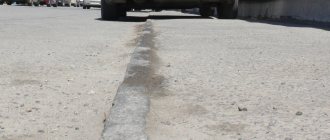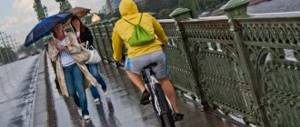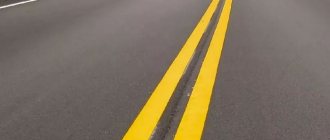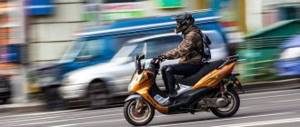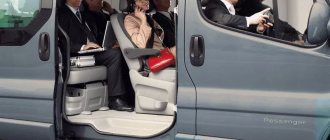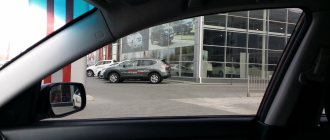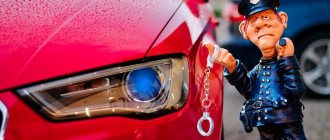AutoUrayt.rf / Questions
Back
Published: 03/19/2020
Reading time: 3 min
1
1598
Tuning is one of the most discussed topics from the point of view of automobile legislation, given that a large number of car owners resort to it. In this article we will talk about the possibility of installing a bumper bar (power bumper) on cars, discuss legal regulation, exceptions, as well as the possibility of its legal installation.
- What does the law say about installing a guardrail?
- Design changes or additional equipment?
- Is it possible to register a kengurin with the traffic police?
- When can you install a kangaroo cage? Old cars
- Imported cars
- Other sanctions
What does the law say about installing a guardrail?
The current legislation prohibits the installation of kenguryat guards on vehicles on the territory of the Russian Federation. However, as with any other rule, there are exceptions.
The main document establishing the requirements for the use of additional devices on vehicles is the Technical Regulations of the Customs Union, which came into force on January 1, 2015, and considers the issues of safe operation of wheeled vehicles (TR CU 018/2011).
This document states that if the technical documentation provides for the installation of a guardrail (power bumper), or the element is installed by the manufacturer, it is not required to dismantle it.
In this case, several requirements must be met: the longitudinal cross-country angle is at least 20 degrees, a distance of at least 18 cm is maintained between the lower point of the body and the road surface, the overhang angle is 25 degrees or more, and the departure angle is at least 20 degrees.
One of the clauses of these Technical Regulations establishes that if a vehicle belongs to categories M1, N1 (their main features, respectively: no more than 8 seats for passengers, weight less than 3.5 tons), then equipping them with structures protruding beyond the perpendicular extreme bumper line point is prohibited.
It is a common belief that SUVs (G category cars) are also an exception, but in fact this is not a separate category, but just a subcategory for each of the two above.
There are two exceptions that may be a consolation for car enthusiasts:
- If the kenguryatnik is planned to be installed as a decorative element. To do this, its weight should be no more than 500 grams, and the material for production should be anything other than steel or a material with similar strength indicators. Thus, on any car you can safely install a structure that can protect the registration plate and lighting devices.
- If you plan to install a certified factory design. This clause includes those car owners whose vehicles are equipped with a guard, but for some reason (for example, equipment) it was not installed earlier.
More on the topic: Reasons for stopping vehicles in [year]
Model examples
Kia Sportage.
Mercedes W463.
Chevrolet Niva.
Renault Koleos 2008.
Toyota RAV4.
Hyundai Santamo.
Design changes or additional equipment?
A kenguryatnik is a frame made of metal pipes by welding. It acts as additional protection by preventing damage to the front of the car .
There is a lot of controversy surrounding the question of which category this element should be classified into: structural elements or additional equipment? According to the text of the Technical Regulations, making changes to the design of a vehicle means the procedure for eliminating those provided for by the design or installing components and pieces of equipment not provided for by the design of the vehicle in question. In this context, changes are considered that were made after the vehicle left the manufacturer and have or may have an impact on the safety of use of the vehicle.
Thus, in cars whose technical documentation does not provide for the presence of a bulge or yoke, it acts as additional equipment (additional body kit). For modifications of this type, it is necessary to go through the procedure for making changes to the documents for the car. You can legitimize the installation of this element by contacting the traffic police.
Classification and types
Since the advent of kangurins, many types of such devices have been created, differing in shape, design features, material used and other aspects.
But there are only two main types:
- Front. The product is mounted on the front of the car and protects the radiator grille and other elements from impact. The device is fixed to the bumper to strengthen it or to other fasteners.
- Rear. This type of kangurin is mounted at the rear of the car and protects the rear bumper from damage. The practice of off-road driving has shown the importance of protection.
Additionally, kenguryatniks can be divided by type in terms of functional features (class).
The following types of hanging grilles are available on the market:
- Standard. The task is to protect the radiator grille and other elements of the body / engine compartment from damage upon impact. In the event of a collision, they do not guarantee 100 percent protection, but they take part of the impact. Additionally, cables are used on the sides to protect the vehicle from being hit by branches.
- Protective. Mounted on headlights at the front and rear of the car. The main function is to protect the surface from stones, branches and other large objects.
- Reinforced. Such designs are used as an addition to an already installed bumper. Externally, they have a massive construction and increased width for better protection of the front. The edges curve to the sides, and the lower part protects the motor from obstacles on the road.
There are two types of kenguryatniks in shape:
- "Horseshoe". They have the appropriate shape, which is where they got their name. Installed at the front and rear of the vehicle. Found on minibuses, SUVs and other cars. Reliably protect the front and bottom of the machine.
- "Safari". The goal is to prevent damage to the grille, fenders and headlights. This design provides special mounts for mounting additional light sources.
Yokes also differ in the material used. Today, protection is made of stainless steel or aluminum. Preference is given to the first option due to greater strength, the possibility of chrome plating the metal and resistance to corrosion. All this guarantees better protection in a collision.
Is it possible to register a kengurin with the traffic police?
In accordance with current legislation, penalties for using kengurin can be avoided in two cases:
- The element is factory installed,
- The installation was agreed upon with the traffic police and properly documented.
To obtain a permit, the vehicle owner will need:
- Contact an appropriately authorized organization to conduct an examination. Specialists will evaluate the possibility of installing a guardrail, and if the decision is positive, the car owner will receive a protocol confirming this fact.
- Submit an application to the traffic police, attaching documents received from the expert organization. Traffic police specialists study the submitted conclusion; if the decision is positive, it is endorsed and returned to the car owner.
- The next step is to contact a service center or install the body kit yourself. if work is planned without contacting a licensed service center, in the application submitted to the traffic police it is necessary to declare all the work that is planned to be carried out during the installation process.
- After the car is equipped with a kangaroo guard, the owner again undergoes an examination, the purpose of which is to confirm compliance with the requirements of legislation and regulatory documents. In case of a positive conclusion, a diagnostic card is issued confirming the suitability of the vehicle for operation.
- Contacting the traffic police to make notes on the installation of additional equipment in the documents.
More on the topic: When and why to “change shoes” for a car
In practice, obtaining permits is almost impossible. Experts at the first stage conclude that the planned change has a direct impact on road safety, which is a direct basis for refusing to install a guardrail. Thus, it is impossible to register a kenguryatnik with the traffic police if the design of the vehicle does not provide for it.
When can you install a kangaroo cage?
Old cars
SUVs (no matter foreign cars or domestic Nivas) produced more than 30 years ago are not subject to the provisions of the Technical Regulations. Therefore, the installed kenguryatnik will not be a reason for imposing a fine. However, even this will not allow its installation to be registered properly.
Imported cars
Imported cars can also be operated with an installed guard on the roads of the Russian Federation. They can be divided into two groups:
- Registered in other countries where the use of kengurin is legal. However, in this case there is a significant limitation: the car can only be imported for a period of up to 6 months.
- Models of SUVs with body kits installed by the manufacturer, imported into the country. There is also a pitfall here: most of them are quite old models, because the Technical Regulations prohibit the import of such cars into the Russian Federation from the moment they come into force.
History of appearance, where the name came from
There is a stereotype that the kangaroo cage was invented by Australian residents who wanted to protect themselves from collisions with large kangaroo animals. In fact, they only adopted the idea, and US farmers became the pioneers.
They were the ones who attached special grilles to the front of the car, designed to disperse livestock. They called their invention a “slaughterhouse” or “bulbar” (literally, a grill for protection from bulls).
Over time, the idea was adopted by truckers from Australia, driving thousands of kilometers along the roads of the continent. They called the product “roo bar,” which means “kangaroo proof.”
Before the advent of kangaroos, any collision with an animal (including a kangaroo) resulted in damage to the car and the need for expensive repairs. Installing a special grill eliminated the problem. In the event of a collision, the grille is slightly deformed, but the radiator and other elements remain targets.
Today, kangurins are installed on SUVs, many crossovers and even passenger cars.
In the early 90s, car owners began to install grilles on almost all car models - Nivas, Nines, Eights and other cars for the purpose of decoration.
Currently
reading
S-AWC all-wheel drive system on Outlander - a marketing ploy or super-all-wheel control
3.9k
Driver's license for bicycles and electric scooters. Will they be introduced in 2021?
3.6k
Such actions have led to negative consequences and deaths on the roads, because in the event of a collision with a person, the pedestrian’s chances of survival are reduced. Against this background, the fight against kangaroos began, bans and fines appeared.
Fine for illegal installation
Owners of vehicles who operate them with an installed guard, but do not have the appropriate permitting marks in their documents, may be held accountable in accordance with Article 12.5 of the Code of Administrative Offences. There is no special sanction for this violation.
The legislation provides for the following types of punishments applied by traffic police officers:
- Warning. Used upon initial detection of an offense. Most often, drivers who really do not know about the illegality of installing an additional body kit and intend to eliminate the violation: remove the guard, or contact the traffic police to obtain permission, get by with a warning. A warning can be dispensed with only once; a repeated stop by the inspector after a lapse of time, in case of evasion of eliminating the violation, will result in the imposition of a fine.
- The amount of the fine established by law for a first-time violation is 500 rubles.
- Ignoring the demands of traffic police representatives for the second time will cost the owner of a “reinforced” car already 5,000 rubles.
More on this topic: Is it possible to paint a civilian vehicle in the colors of first responders?
Thus, a monetary penalty for lack of permission to install a power bumper can be a significant blow to the car owner’s budget. In the case of repeated prosecutions in the form of a fine, which have no result, other penalties may be brought against the owner.
Other sanctions
In addition to fines of up to 5,000 rubles, which were mentioned above, traffic police officers can deprive the owner of a vehicle equipped with a homemade yoke of the right to drive for up to three months. This penalty is applied in the case of repeated imposition of fines that have not brought results.
Inspectors may also cancel the registration of a vehicle, but in order to re-register, the violations will still have to be eliminated.
Another problem may be the expiration of the diagnostic sheet required for issuing an MTPL policy. Additional design elements not provided for by the design of the car or without permits are a clear obstacle to issuing a conclusion on the suitability of the vehicle for use.
Characteristics of kengurin for cars
The guard is an additional protective grille placed on the bumper of the car. Basically, this tuning element is installed on SUVs, that is, vehicles with significant dimensions. The main purpose of this installation is to emphasize the greatness, power, and scale of the “iron horse”.
In the old days, Australian and American farmers installed kenguryatniks to move cattle to pasture. These guards could be used to keep the front end of a huge pickup truck from getting dented in a collision with livestock. Such protection began to be used by off-road driving enthusiasts; you can see this accessory on crossovers and jeeps produced by different automobile concerns:
The fake version will not be able to protect against dents on the car as a result of accidents; it only serves decorative purposes.

